Whassup readers! How have you been? We got so many requests to explain Dominos Marketing Strategy… So here we are to explain the same!
Take a deep breath and think of having a delicious Pizza… What’s the first name that comes to your mind on hearing the term “Pizza”? Domminos! Right? It became synonymous with Pizza, especially in India.
A foreign brand ruling the pizza industry of India… That’s no joke!
Guess what? Pizza authentically belongs to Italian food but Dominos isn’t an Italian brand. It is an American brand. All thanks to Dominos marketing strategy.
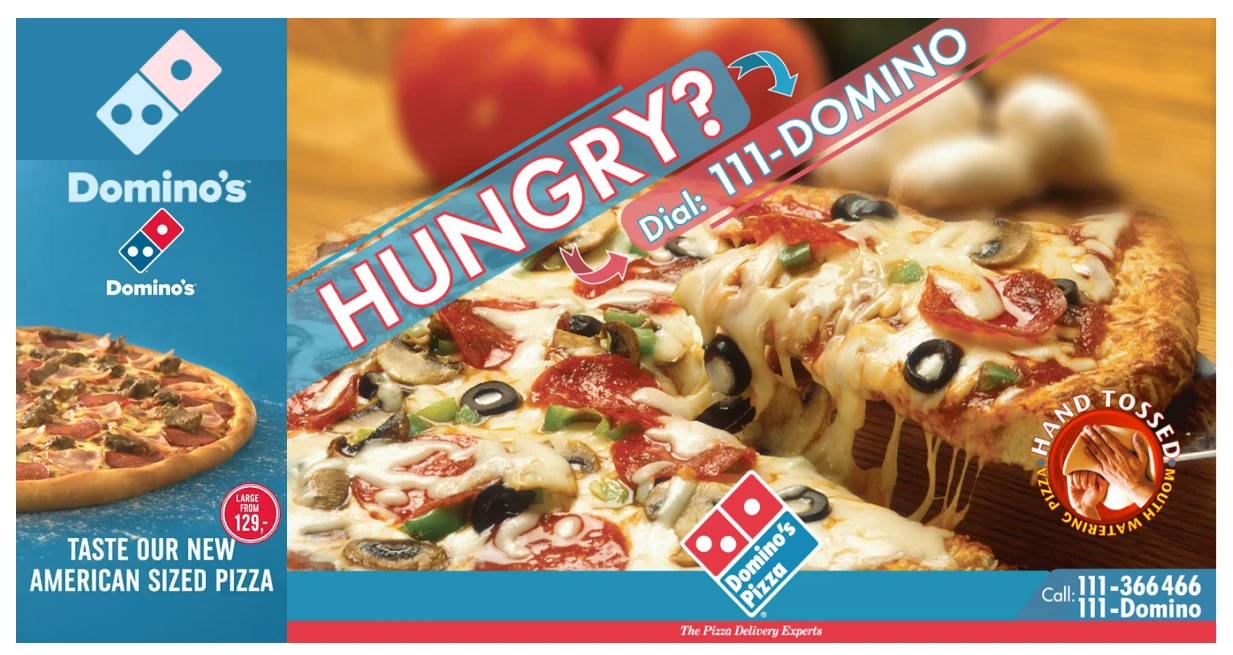
We all know the invaluable significance of marketing in today’s world. With so much competition, you need to tell the customer “Our product is awesome, please try it and you will love it!”
But not so blatantly…
You need to use a high degree of creativity to catch the eyes and win the hearts of the audience so that they can turn into loyal customers.
That’s exactly what Dominos did! How? Do you remember that ad for cheese burst pizza or chocolate lava cake over a decade ago? Those were all a part of Domino’s marketing strategy.
So, let’s delve into Dominos marketing strategy in detail.
Keep reading!
(A) Dominos: A Brief Overview
Domino’s, established in 1960, stands as a prominent American multinational pizza restaurant chain. The ownership of the chain rests with the master franchisor Domino’s Pizza, Inc., overseen by CEO Russell Weiner. Operating under Delaware domicile, the corporate headquarters is situated at the Domino’s Farms Office Park in Ann Arbor Township, near Ann Arbor, Michigan.
Before delving further into Dominos marketing strategy, let’s delve into its profile-
| Name of the Company | Domino’s |
| Former Name | Domino’s Pizza (1960-2012) |
| Type of Company | Publicly Listed |
| Operating Industry | Foodservice,Franchising |
| Founded | December 9, 1960; 63 years ago in Ypsilanti, Michigan, U.S. |
| Founders | James Monaghan, Tom Monaghan, Dominick DeVarti |
| Headquarters | Domino’s Farms Office Park, Ann Arbor Township, Michigan, United States |
| Number of Locations | 18,848 (As of Jan 2, 2022) |
| Area Served | Worldwide |
| Products | Pizza, Chicken wings, Dessert, Pasta, Submarine sandwiches |
| Services | Food Delivery |
| Competitors | Pizza Hut, KFC, McDonald’s, Subway, Taco Bell, Burger King, Papa Johns Pizza, Smokin Joes Pizza, etc. |
As of 2018, Domino’s boasted an extensive global presence, with around 15,000 stores distributed worldwide. Notably, the United States housed 5,649 stores, India accommodated 1,500, and the United Kingdom hosted 1,249. This expansive reach extends to over 83 countries, encompassing 5,701 cities globally.
(B) Legendary Representation of the Logo
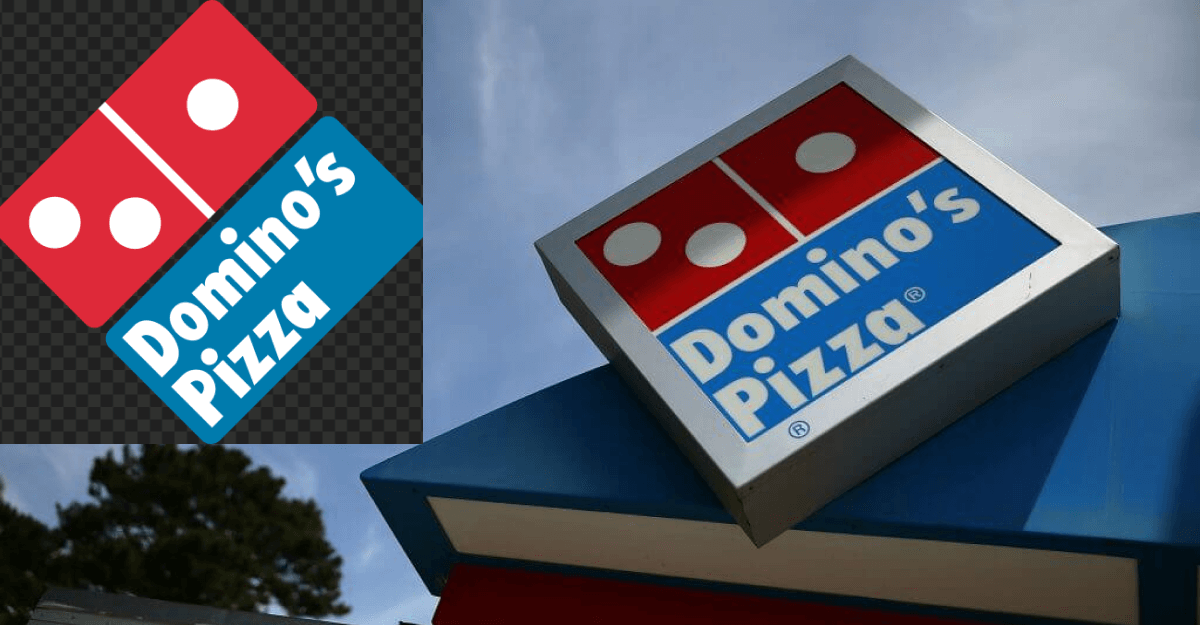
The Dominos logo, a stylized representation of a domino tile with three dots, is more than just a decorative element.
Exploring Domino’s logo history offers a unique insight into the brand’s evolution. The logo we know today is an evolution of the original visual identity chosen for the company when it first selected its new title.
The three dots in the company logo represent the first three Domino’s locations in Ypsilanti, Michigan, and serve as a reminder of the company’s origins.
The logo’s white, red, and blue symbolize virtue, strength, passion, and reliability. They’re bright, well-balanced, and easily approachable. The simple geometry in the logo also ensures it’s easy to remember and timelessly modern.
Pizza lovers all over the world may recognize the company name and emblem because of the vibrant blue letters and white background that they create.
(C) History of Dominos
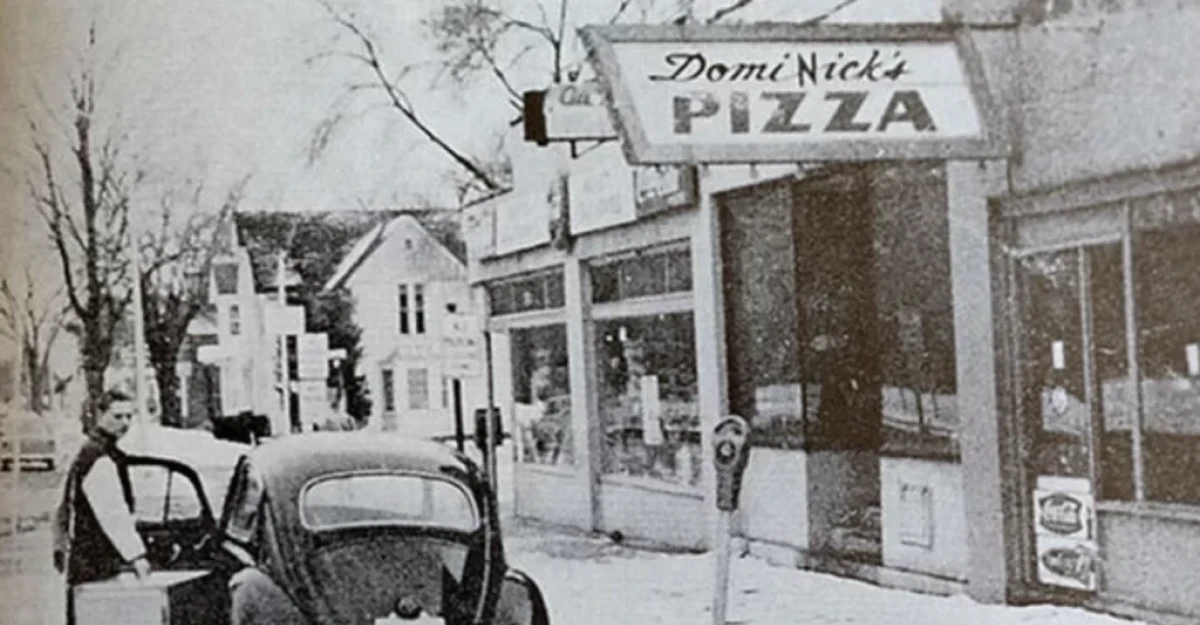
Back in 1960, the pizza revolution began when Tom and James Monaghan kicked off Domino’s in Ypsilanti, Michigan. Their mission? To bring sizzling hot pizzas straight to your doorstep – talk about a game-changer! Little did they know, this small venture was destined for global triumph.
As the years rolled on, Domino’s spread its pizza prowess, planting its flag in new territories. In the late 1970s, there were 200 stores scattered nationwide. Fast forward to the 2000s, and Domino’s was not just delivering pizzas – it was serving up a modern makeover.
New menu selections, a cutting-edge website, and a user-friendly mobile app made ordering Domino’s a breeze.
| Year | Events & Milestones Achieved |
| 1960 | Domino’s began with a single store in Ypsilanti, Michigan, under the leadership of Tom Monaghan. |
| 1965 | The company expanded with its first franchise location. |
| 1978 | The iconic 30-minute delivery guarantee was introduced. |
| 1983 | The first international Domino’s store opened in Winnipeg, Canada, followed by Queensland, Australia. Domino’s Pizza, Inc. became the master franchisor. |
| 1986 | The infamous Noid character appeared in Domino’s advertising campaigns. |
| 1989 | Domino’s introduced the Handmade Pan Pizza, and its 5,000th store opened worldwide. |
| 1992 | Breadsticks joined the menu as Domino’s first national non-pizza item. |
| 1994 | Domino’s launched its chicken product, Buffalo Wings. |
| 1995 | Domino’s expanded into 40 international markets, including Eastern Europe and Africa. |
| 1998 | Founder Tom Monaghan retired, and ownership was transferred to Bain Capital Inc. Online ordering makes its debut, changing the pizza game. |
| 2004 | Domino’s became a publicly traded company on the New York Stock Exchange (NYSE). |
| 2007 | Online and mobile ordering options were introduced for customer convenience. |
| 2008 | The groundbreaking Domino’s Tracker allowed customers to follow their order progress online. |
| 2009 | Domino’s unveiled its “new and inspired pizza” recipe. |
| 2010 | The Domino’s mobile app revolutionizes pizza ordering. |
| 2011 | Named “Chain of the Year” by Pizza Today Magazine for the second consecutive year. |
| 2012 | A new logo and “pizza theater” store design enhanced the pizza-making experience. |
| 2013 | Pizza Profiles on dominos.com streamlined online ordering. |
| 2015 | Domino’s DXP™, a specialized pizza delivery vehicle, was introduced on the roads. |
| 2017 | Domino’s collaborated with Ford to explore self-driving vehicles for pizza delivery. |
| 2018 | Domino’s boasts a global presence with approximately 15,000 stores. |
| Present | Continues to innovate and deliver pizza joy worldwide. |
And here we are today, with over 17,000 stores sprinkled across 90+ countries. Domino’s isn’t just a pizza chain; it’s a global pizza sensation. Quality and convenience are the secret ingredients, ensuring that every Domino’s experience is a delicious delight. So, whether you’re craving a classic or exploring new flavors, Domino’s is here to deliver the pizza magic!
(D) Dominos Target Audience: STP Analysis of Dominos Pizza
The STP analysis of Dominos Pizza will help us to examine how this Pizza company placed itself successfully in the competitive market. To the uninitiated, let me tell you that STP analysis is a marketing framework that is mainly used to target the right audience.
The acronym STP stands for Segmentation, Targeting, and Positioning-
(D.1) Segmentation: Understanding the Diverse Pizza Palate
It involves the segregation of the market into different customer groups with similar characteristics and needs. Dominos uses various segmentation variables with which it can easily identify its target customer segments-
| Segmentation | Description |
| Demographic Segmentation | Domino’s embraces a broad spectrum of customers, considering factors like age, income, family size, and occupation. Families, students, young professionals, and those seeking affordability find a place in Domino’s diverse customer base. |
| Geographic Segmentation | Targeting specific locations, Domino’s factors in population density, urban vs. rural settings, and regional tastes. The aim is to tailor offerings to local preferences, creating a pizza experience rooted in the community. |
| Psychographic Segmentation | Taking into account lifestyle, attitudes, and behavior, Domino’s attracts customers valuing convenience, fast delivery, and a plethora of customization options. It’s about catering to the unique preferences that define a customer’s pizza journey. |
| Behavioral Segmentation | Understanding buying behaviors, Domino’s caters to both frequent and occasional pizza consumers. Through promotional deals, loyalty programs, and menu innovations, it fosters a pizza culture that encourages repeat purchases. |
(D.2) Targeting: Delivering the Domino’s Experience to the Right Door
It involves the selection of particular customer segments to focus on the usage of the right type of marketing strategies-
| Targeting | Description |
| Convenience Seekers | For busy families, students, and professionals craving a convenient meal option, Domino’s positions itself as the go-to choice for quick and hassle-free food delivery. |
| Tech-Savvy Customers | Catering to tech enthusiasts, Domino’s provides user-friendly online platforms, and innovative ordering options, and embraces technology trends like voice-activated devices and social media integration. |
| Value-Oriented Customers | Targeting price-conscious customers, Domino’s offers combo deals, discounts, and loyalty programs. It ensures that customers seeking value for money find their pizza cravings met. |
| Customization Enthusiasts | For those who love to personalize their pizza orders, Domino’s offers an array of crusts, toppings, and sauces, creating a unique dining experience for every individual. |
(D.3) Positioning: Domino’s Unique Flavor in the Pizza Landscape
It refers to the condition where the brand captures a specific place in customer’s hearts and minds based on different aspects. Dominos has strategically positioned itself in your mind through the following elements-
| Positioning | Details |
| Fast and Reliable Delivery | Positioning itself as a leader in pizza delivery, Domino’s emphasizes a commitment to delivering hot and fresh pizzas within a specified timeframe, building a reputation for reliability. |
| Innovation and Technology | Domino’s establishes itself as a technology-driven brand, leveraging online ordering, mobile apps, and GPS tracking systems. It communicates a commitment to innovation and customer-centricity. |
| Quality Ingredients and Customization | Positioning itself as a brand using high-quality ingredients and offering extensive customization options, Domino’s prioritizes customer satisfaction and personalization. |
| Affordable Pricing | As a value-oriented brand, Domino’s ensures competitive prices through affordable options and regular promotional deals, appealing to customers conscious of their budget. |
By seamlessly integrating Segmentation, Targeting, and Positioning, Domino’s Pizza successfully identifies, engages, and positions itself as a leader in the pizza delivery market. This strategic approach allows Domino’s to communicate its value proposition, foster customer loyalty, and maintain a competitive edge in the industry.
(E) Dominos Marketing Strategy: 4Ps Marketing Mix
Let’s look at the key principles of Dominos marketing strategy. It includes the 4Ps marketing mix i.e. Product, Price, Place, and Promotion. So here are those-
(E.1) Product: A Culinary Adventure
At the heart of Domino’s strategy is its diverse product range. Beyond just pizza, Domino’s offers an extensive menu catering to various tastes. Whether you’re a fan of classic flavors or crave the excitement of specialty options, Domino’s has you covered. The crust options, including thin crust, hand-tossed, and pan, provide a customizable base.
Toppings and sauces offer a myriad of choices, ensuring a personalized pizza experience. Complementing the star attraction, side dishes like breadsticks, chicken wings, pasta, salads, and desserts add depth to the culinary journey.
Domino’s commitment lies in delivering not just a meal but an experience – one that prioritizes high-quality, fresh ingredients across its entire menu.
(E.2) Price: A Pocket-Friendly Feast
Domino’s pricing strategy is a delicate dance between affordability and value for money. Consideration of ingredient costs, production expenses, and market demand informs the setting of prices.
The menu boasts a variety of pricing options, accommodating single pizza orders, combo deals, and value meal packages. Regular promotions, discounts, and loyalty programs sweeten the deal, creating a pricing structure that caters to a diverse customer base.
The goal is clear – to ensure that enjoying Domino’s isn’t just a culinary delight but also friendly on the wallet.
(E.3) Place: Strategically Located, Technologically Enabled
Domino’s doesn’t just rely on physical proximity; it strategically selects locations near residential areas, commercial districts, and educational institutions to maximize accessibility. Investing significantly in technology, Domino’s offers a seamless online ordering and delivery experience.
The mobile app and website serve as gateways, allowing customers to effortlessly locate nearby stores, place orders, and track deliveries. It’s about bringing the Domino’s experience to your doorstep with the click of a button.
(E.4) Promotion: Crafting Narratives, Engaging Audiences
Domino’s doesn’t just sell pizza; it weaves stories. Advertising campaigns span television, radio, print, and digital platforms, showcasing the brand’s strengths. The emphasis is on fast delivery, fresh ingredients, and a plethora of customization options.
Social media becomes a dynamic arena, where Domino’s engages customers, shares tempting offers, addresses inquiries, and runs interactive campaigns. Beyond that, public relations efforts, sponsorships, and community engagement initiatives contribute to building a positive brand image and fostering lasting relationships.
In essence, Domino’s Pizza’s marketing mix is a sophisticated blend of culinary creativity, affordability, accessibility, and compelling narratives. The meticulous alignment of product, price, place, and promotion has propelled Domino’s to the forefront of the pizza industry, earning not just customers but loyal enthusiasts who savor Domino’s experience.
(F) Home Delivery of Pizza: Gamechanger for Dominos
Domino’s revolutionary introduction of home delivery transformed the pizza landscape and catapulted the brand into an unprecedented success. In 1960, Domino’s disrupted the traditional dine-in model by pioneering carryout pizza delivery. This groundbreaking concept eliminated the need for customers to visit a restaurant, offering a novel and convenient way to enjoy pizza in the comfort of their homes or workplaces.
This delivery-centric strategy proved to be a game changer on multiple fronts. It not only enhanced customer convenience but also tap
ped into a new market segment – those seeking a quick and hassle-free meal solution. The ability to savor Domino’s pizza without leaving home became a compelling proposition, attracting a surge of customers and creating a unique niche for the brand.
Moreover, this innovative approach fueled Domino’s exponential growth, propelling it to serve over 60 million customers weekly across more than 85 countries. The 30-minute delivery promise, although evolved, further solidified Domino’s commitment to fast service.
Ultimately, home delivery positioned Domino’s as a leader in the food delivery industry, reshaping consumer expectations and setting the standard for quick and reliable pizza service globally.
The simplicity of having pizza brought to one’s doorstep revolutionized the industry, making Domino’s a household name synonymous with efficient and enjoyable pizza experiences.
(G) Conventional Dominos Marketing Strategy: A Closer Look
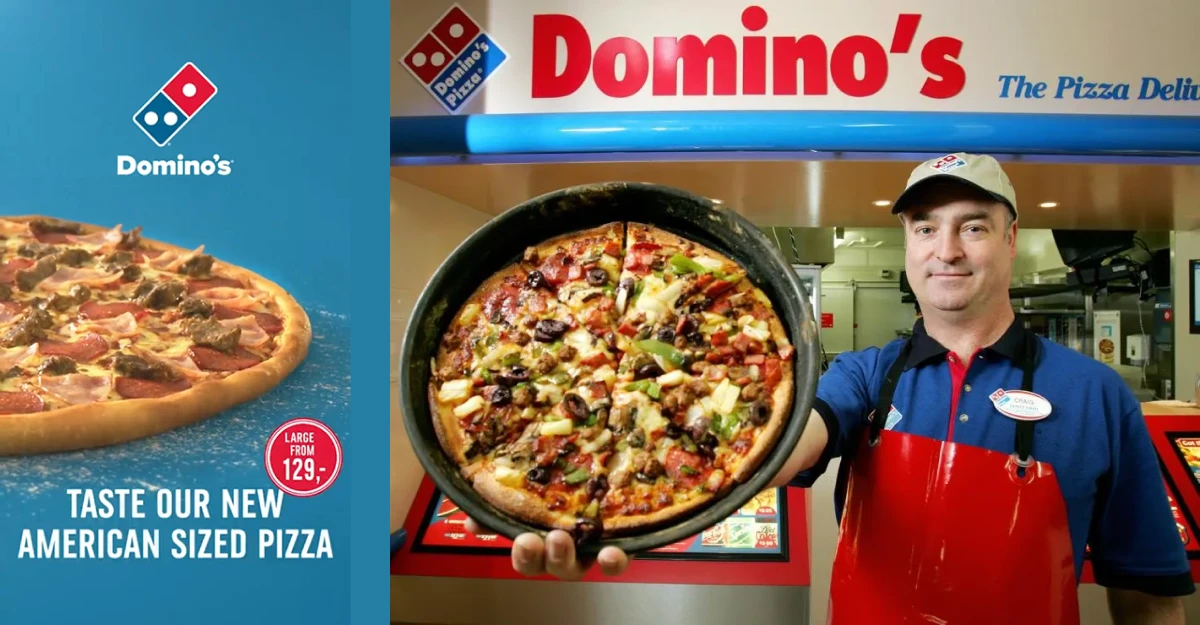
Let’s look at some of the conventional Dominos marketing strategies that were highly impactful in winning the hearts of the customers-
(G.1) Domino’s Food Culture Impact
In 1960, Domino’s shook up the pizza scene by introducing carryout pizza delivery. This innovative concept allowed customers to enjoy pizza without leaving their homes or offices, making the experience quicker and more convenient. Fast forward to today, and Domino’s serves over 60 million customers weekly, spanning a presence in more than 85 countries. This delivery-centric approach has been a driving force behind the brand’s exponential growth.
(G.2) Domino’s 30-minute Promise
A quirky yet effective Domino’s marketing strategy involved a bold promise – delivering pizza in less than 30 minutes or a free pizza as a “thank you” for patience. This not only won over new customers but also set a standard for all new outlets at franchise locations.
The 30-minute guarantee, although no longer in effect, remains a testament to Domino’s commitment to fast service and customer satisfaction.
(G.3) The Brand’s Familiarity
Domino’s strategic marketing cultivated a reputation for high-quality food and swift service, primarily through the 30-minute delivery promise. This familiarity has made Domino’s a go-to choice for busy workdays, and its iconic promise of delivering every pizza in 30 minutes or less has become a household mantra.
The brand’s popularity is further fueled by customers trying for a free pizza if the deadline is missed, serving as a clever promotion tactic.
(G.4) Domino’s is Everywhere
Beyond its innovative delivery strategy, Domino’s has expanded its footprint globally, reaching over 100 countries. This extensive reach has not only garnered a loyal following but also positioned Domino’s as a top player in the food delivery industry.
The lesson learned here is clear – global expansion is key for business growth, requiring thorough market research and an expansion-oriented mindset.
(G.5) Consistent Quality and Innovation
Domino’s maintains its industry dominance by consistently delivering quality, taste, and innovation. The brand stands out by using top-notch ingredients and offering a diverse range of pizza choices to suit varied preferences.
A shining example of adaptability and innovation came during the COVID-19 pandemic, where Domino’s swiftly implemented contact-free home delivery practices, staying ahead of competitors and meeting customer needs effectively.
(G.6) Any Promotions and Discounts? Yes Always!
Ever noticed Domino’s always has enticing offers? Regular promotions and discounts, like the famous BOGO deals, have become a staple in Domino’s marketing strategy. These discounts not only attract customers seeking cost-effective choices but also convert Pizza Hut enthusiasts into Domino’s loyalists.
The strategy here is simple – keep the offers rolling in, and the customers keep coming back.
In short, Domino’s marketing strategy is a journey through innovative concepts, bold promises, global expansion, quality maintenance, and strategic promotions. Each aspect plays a crucial role in Domino’s continued success, making it not just a pizza brand but a global culinary phenomenon.
(H) Dominos Marketing Strategy: Digitally Driving Customer Engagement
In this section, we will see how Dominos is applying the modern marketing methods-
(H.1) Social Media Presence: Building a Digital Community
Domino’s Pizza has harnessed the influential realm of social media to create a robust online presence. Actively engaging on platforms like Facebook, Twitter, Instagram, and YouTube, the company shares promotions, addresses queries and runs interactive campaigns.
Innovations like the “Domino’s AnyWare” campaign, allowing orders through Twitter, Facebook Messenger, and voice-activated devices, showcase their commitment to convenience, fostering community and brand loyalty.
(H.2) Digital Advertising: Precision Targeting for Impact
Domino’s employs data-driven digital advertising tactics, including SEO, paid search marketing, display advertising, retargeting, email marketing, and social media advertising.
Vibrant ad creatives feature bold colors, animations, catchy headlines, and delectable visuals, effectively showcasing products. This strategic approach allows Domino’s to target specific demographics and regions with tailored precision.
(H.3) Compelling Advertising Campaigns: Creativity Meets Customer Connection
Known for creative and engaging campaigns, Domino’s memorable initiatives like the “You Got 30 Minutes” guarantee and the “Pizza Turnaround” campaign resonate with audiences.
Beyond showcasing quality and customer service, these campaigns use humor, storytelling, and relatable scenarios to capture attention and differentiate Domino’s from competitors, creating lasting brand impressions.
(H.4) Emphasis on Convenience and Delivery: Streamlining the Pizza Journey
A core marketing strategy revolves around Domino’s emphasis on convenience and efficient delivery. Recognizing the value of quick and hassle-free food delivery, the company invested in technology, introducing online ordering, mobile apps, and GPS tracking systems.
This focus on convenience solidifies Domino’s position as a go-to option for fast and reliable pizza delivery.
(H.5) Special Offers: Tempting Deals for Every Palate
Domino’s keeps the competitive spirit alive with daily deals, bundled combos, seasonal specials, and personalized discount codes. These promotional activities not only attract customers but also keep them returning for more, ensuring a steady flow of satisfied pizza enthusiasts.
(H.6) Gamification: Turning Ordering into an Interactive Adventure
Engaging users with interactive games on their website, Domino’s incorporates spin wheels, scratch cards, quizzes, trivia contests, guessing games, and prize giveaways.
Beyond entertainment, these gamified elements reward participants with prizes, ranging from free pizza credits to merchandise, creating a fun and rewarding experience.
(H.7) Food Blog Collaboration: Influencers Paving the Way
By partnering with influential figures in the foodie space, such as bloggers, YouTubers, Instagrammers, and TikTokers, Domino’s leverages their large following and expert opinions.
Collaborative content, including reviews, tutorials, recipe hacks, unboxing videos, taste tests, and social media takeovers, harnesses the influencers’ popularity to build brand trust and reputation.
(H.8) Menu Innovation and Personalization: A Culinary Journey
To meet evolving customer preferences, Domino’s continuously introduces innovative menu offerings. Regular market research and experimentation with new flavors, crusts, and toppings keep the menu fresh and exciting. Allowing customers to customize their pizzas according to preferences ensures a personalized dining experience, catering to a wide range of tastes.
(H.9) Loyalty Programs and Discounts: Rewarding the Pizza Enthusiast
Utilizing loyalty programs and discounts, Domino’s incentivizes repeat purchases and fosters customer loyalty. The “Piece of the Pie Rewards” program allows customers to earn points for every purchase, redeemable for free pizzas or other rewards. Regular promotions, special offers, and combo deals encourage customer retention and generate positive word-of-mouth marketing.
(H.10) Franchisee Network Support: Consistency Across the Domino’s Realm
With nearly 7,000 franchised stores globally, Domino’s prioritizes its franchise network support system. Offering training modules, operations manuals, product innovation insights, and marketing programs ensures consistency in executing effective marketing plans. A robust relationship between corporate teams and franchise owners maintains scalability and effectiveness.
(H.11) Emphasizing Sustainable Practices: A Green Commitment
As part of the green initiative, Domino’s implements changes to packaging materials, recycling processes, energy usage, waste management, and sourcing practices. Communicating progress through various channels appeals to environmentally conscious consumers, showcasing a commitment to responsible choices.
(H.12) CSR Engagement: Giving Back to Communities
Dedicated to giving back, Domino’s engages in charitable donations, volunteer services, scholarship programs, disaster relief aid, and employee matching gift projects. These philanthropic efforts enhance the brand’s image, resonating with socially aware audiences seeking meaningful impact from the brands they support.
In deploying this range of effective marketing strategies, Domino’s Pizza has not only positioned itself as a leader in the competitive pizza industry but has also captured customer attention fostered brand loyalty, and sustained its impressive growth and success.
(I) Memorable Ad Campaigns of Dominos Marketing Strategy
Ad campaigns are the backbone of any successful marketing strategy, and Domino’s has been a trailblazer in this arena for decades. Domino’s consistently sets the standard for pizza chains globally, from pioneering the “30 minutes or less” promise to venturing into innovative digital marketing.
Let’s go through some of Domino’s most impactful and game-changing ad campaigns that have left a lasting imprint on both the brand and customers.
(I.1) Domino’s Fashion Week Debut
In an unexpected twist during London Fashion Week 2019, Domino’s made a stylish entrance into the fashion world. Teaming up with designer Liam Hodges, Domino’s unveiled the “Night In” collection, a comfort-driven ensemble inspired by the trend of staying in.
Featuring unique items like the “Controller Coat” and the “Boxset Blanket,” the campaign aimed to redefine memorable nights at home. The collaboration generated social media buzz, complemented by a competition offering users the chance to win these exclusive designs.
(I.2) The Last Slice
Celebrating International Friendship Day in 2022, Domino’s India initiated the heartwarming #Thelastslice campaign. A social experiment orchestrated by Schbang, the campaign brought strangers together over the last slice of pizza.
The humorous experiment showcased the impact of a single slice, fostering new connections and proving that even the smallest things can create meaningful bonds.
(I.3) Domino’s Puts Local Marketing on the Map
Recognizing the importance of local connections, Domino’s launched the ‘Paving for Pizza’ campaign in 2018. Addressing the issue of potholes, Domino’s invited customers to nominate their towns for paving grants, ensuring smooth pizza deliveries.
This campaign not only sparked social media discussions but also highlighted Domino’s commitment to positive community impact. With an impressive 35,000 organic mentions on social media in the first week, ‘Paving for Pizza’ demonstrated that global brands can make a tangible difference on a local scale.
(I.4) Tweets for Treats
In March 2012, Domino’s UK introduced the innovative “Tweets For Treats” Twitter promotion to boost lunchtime orders. Offering discounts for tweets with the hashtag #letsdolunch, Domino’s witnessed a surge in engagement.
The campaign, with 825 tweets, substantially increased online pizza sales by 43% and overall revenues by 14.6%, showcasing the brand’s ability to leverage social media for both customer engagement and revenue growth.
In these successful campaigns, Domino’s has not only showcased creativity and innovation but has also demonstrated its commitment to connecting with customers on a personal and local level, reinforcing its status as a marketing maestro in the pizza industry.
(J) Businesswise Performance of Dominos
The following table provides a comprehensive overview of Domino’s financial standing, showcasing its market capitalization, revenue generation, operational income, and other crucial financial metrics. Here we will get to know how Dominos is performing financially-
| Business Aspects of Dominos | Details |
| Market Capitalization | US$ 14.81 billion (2024) |
| Revenue | US$4.357 billion (2021) |
| Operating Income | US$780.4 million (2021) |
| Net Income | US$510.4 million (2021) |
| Total Assets | US$1.671 billion (2021) |
| Total Equity | -US$4.209 billion (2021) |
| Expenditures | US$94.172 million (2022) |
| Profit/Loss | US$1.700 billion (2023) |
The table provides key financial insights into Domino’s business aspects, offering a snapshot of its market performance and economic standing. As of 2024, Domino’s boasts a substantial market capitalization of US$14.81 billion, indicative of its significant presence and value in the market.
In terms of revenue, the company generated a substantial US$4.357 billion in 2021, reflecting a robust financial performance. The operating income of US$780.4 million in the same year demonstrates effective operational management and efficiency. Net income, amounting to US$510.4 million in 2021, indicates profitability after deducting expenses.
Total assets of US$1.671 billion underscore the substantial resources and investments made by Domino’s. Interestingly, the total equity figure of -US$4.209 billion raises questions about the company’s financial structure, suggesting possible liabilities exceeding assets.
Expenditures of US$94.172 million in 2022 signify ongoing investments, possibly in areas like innovation, marketing, or infrastructure. The profit/loss of US$1.700 billion in 2023 reveals a notable financial outcome, though the specific details of gains or losses require further exploration.
(K) Key Takeaways from Dominos Marketing Strategy
In this section, we will discuss what we learned from Dominos marketing strategy-
| Takeaways | Description |
| Prioritizing Convenience | Domino’s distinguishes itself by prioritizing user-friendly digital ordering and efficient delivery, making convenience a cornerstone of its strategy. |
| Innovative Technological Integration | Incorporating AI-powered chatbots and GPS tracking into daily operations showcases Domino’s commitment to inventive methods and operational transparency. |
| Customer-Centric Approach | Valuing client feedback and incorporating it into strategies emphasizes the paramount importance of prioritizing customers in Domino’s marketing strategy. |
| Distinctive Brand Identity | Domino’s expertly crafts a unique brand image through iconic logos and memorable jingles, ensuring a lasting presence in the minds of consumers. |
| Global Growth with Cultural Sensitivity | Successfully entering diverse markets, Domino’s adapts to regional tastes and cultural norms while maintaining a robust and recognizable brand identity. |
The success of Domino’s in the intensely competitive fast-food industry is attributed to innovative and data-driven marketing strategies. As the food market matures, observing how Domino’s retains innovation and its competitive edge will be intriguing.
(L) Summing Up Dominos Marketing Strategy
Domino’s Pizza has masterfully woven together innovation, customer-centricity, and adaptability into a compelling marketing strategy. From a strong digital presence to impactful local initiatives and creative ad campaigns, Domino’s engages customers on multiple fronts. Loyalty programs, discounts, and robust franchisee support drive sustained growth. The brand’s unwavering commitment to quality, global expansion with regional sensitivity, and dedication to convenience have solidified its standing in the fiercely competitive fast-food industry. Domino’s success is not merely in delivering pizzas but in delivering a comprehensive and resonant brand experience that keeps customers coming back.

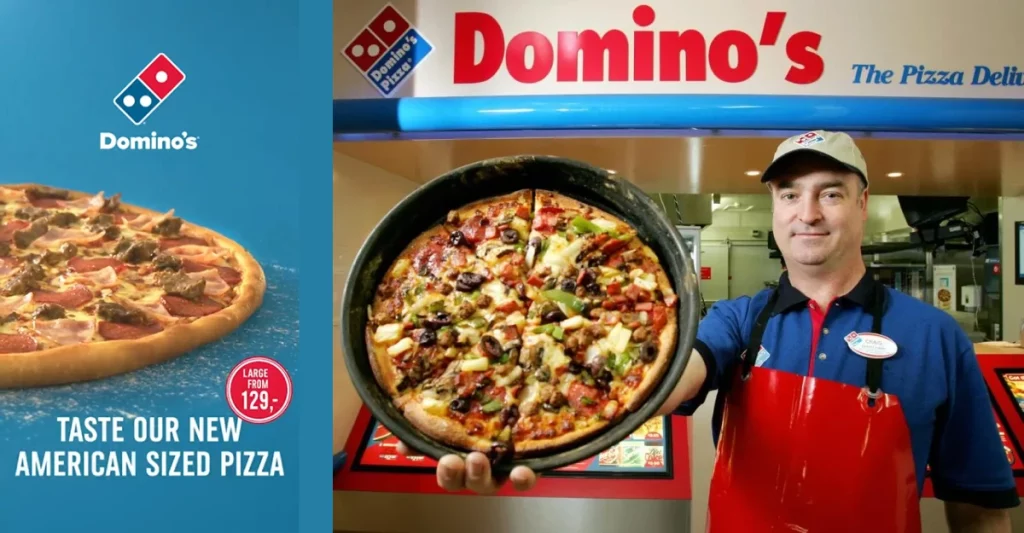
Dominos pizzas are really delightful, along with that it’s other offerings are a must to try!